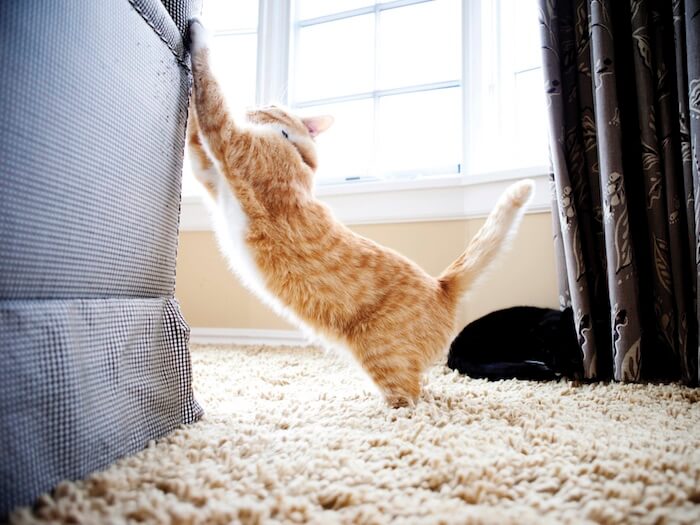Scratching is a completely normal and healthy behavior for cats and it serves many purposes. Cats scratch to stretch their muscles, shed old cuticle, sharpen their claws, and leave scent marks. It is important to provide your cat with suitable ‘scratchers’ where they can exhibit normal scratching behavior. Consider the following factors to choose the right scratcher or your cat.
What Does Your Cat Like to Scratch?
It is important to experiment with a variety of textures and types of scratchers to determine your cat’s preference. Cats that scratch chair legs or the corners of your couch may prefer a vertical scratcher. Make sure that vertical scratchers are tall enough so that your cat can stand up and stretch to scratch. Cats that scratch rugs/carpets may prefer a horizontal scratching post/mat. Choose a material that is similar to what your cat likes to scratch. Vertical or upright and horizontal or flat scratchers are available in a variety of sizes and materials including sisal, wood, carpet and cardboard. Be sure to get one that is large enough to let your cat get a good stretch, and sturdy enough not to fall over during use! Make sure that using scratching posts is very appealing to your cat! This can be done by playing with your cat in these areas, stashing treats on scratching posts and praising/rewarding him for using the scratchers!
Where Does Your Cat Scratch?
The placement of scratchers is very important! Cats often stretch/scratch when they wake up; consider placing one near where your cat sleeps. Cats scratch to leave scent marks (pheromones) that define their territory and tell other cats they have passed through. Multi-cat households may need several scratching posts, both vertical and horizontal, located throughout the house. Put these posts in areas where the cats congregate, and along their routes to common areas such as food/ water bowls, and litter boxes. Having multiple scratching posts provides your cats with acceptable places to leave their mark without ruining furniture and carpets.
It can be effective to place a scratcher near your cat’s preferred (yet undesirable) scratching object (e.g. corner of the couch) and cover that object with something your cat doesn’t like, such as double-sided sticky tape, aluminum foil, or a plastic carpet runner with the pointy side up. You also may give objects you don’t want scratched an objectionable odor by spraying a citrus scent, perfume, or other odor your cat doesn’t like on it. This will only be temporary, as your cat learns where it is appropriate to scratch. Remember never punish your cat by hitting or yelling as this will only make them afraid of you.
When your cat is consistently using the scratching post, you can very gradually (no more than three inches each day) move it to a location more suitable to you. It’s best, however, to keep the scratching post as close to your cat’s preferred scratching locations as possible.
Pheromones
Feline Interdigital Semiochemical
When a cat marks an area by scratching, their toes and foot pads release the feline interdigital semiochemical (F.I.S). All cats need to scratch. Scratching helps them mark their territory. This leaves both visual scratch marks and pheromone markers. It also helps them to feel secure in their surroundings. And scratching feels good to your cat! The F.I.S pheromone encourages your cat to scratch. This can make it difficult to move your cat’s scratching place, especially if they’ve chosen to use your couch. FELISCRATCH by Feliway® mimics the natural FIS pheromone. When combined with the other ingredients in FELISCRATCH, a blue colorant and catnip, it will entice cats to scratch on the scratching post. Feline Facial Pheromone Continued scratching by cats may be related to stress, anxiety, attention seeking, or a perceived lack of security in their environment. Anxiety can also be intensified by punishment, thus driving the cat to increase scratching behaviors. The feline facial pheromone is a comforting pheromone. It provides a sense of reassurance for cats in their environment. These ‘happy messages’ help cats feel safe and secure. Feliway® Classic Diffuser and Spray both mimic the natural feline facial pheromone. It reduces stress and stress-related behaviors.
Applying Feliway® spray on the objects in your home where your cat has exhibited undesired scratching can prevent your cat’s need to mark these areas again. If undesirable scratching occurs in several rooms, indicating a more generalized anxiety/stress, it is recommended to also utilize Feliway® diffusers to help provide an overall sense of comfort for your cat in their home environment.
Routine Nail Trims
Regularly trimming your cat’s claws can prevent injury and damage to household items. Proper feline nail trimmers should be used to prevent splintering of the claws. If possible, start trimming as kittens so they become comfortable with the process early on. Before trimming your cat’s claws, accustom her to having her paws handled and squeezed. You can do this by gently petting her legs and paws while giving her a treat. This will help to make it a more pleasant experience. Always trim nails in a calm environment and provide lots of positive reinforcement! If your cat does not tolerate nail trims at first, start slow, take breaks, and make it a familiar routine. Ask your veterinarian for advice and a demonstration on trimming your cat’s claws.
Temporary Nail Caps
These plastic caps are glued over your cat’s nails to help prevent human injury and damage to household items. The nail caps usually need to be reapplied every 4-6 weeks; therefore may be a less desirable alternative to regular nail trimming and suitable scratchers. These nail caps can be difficult for owners to apply correctly and may need to be applied by your veterinarian.
You can live harmoniously alongside your cat with claws and still maintain nice furniture by understanding a bit more about your cat’s natural behaviors, and enriching your home with items your cat can scratch!
Source: ARL – Animal Rescue League of Iowa, Inc. 2021 – https://www.arl-iowa.org/
